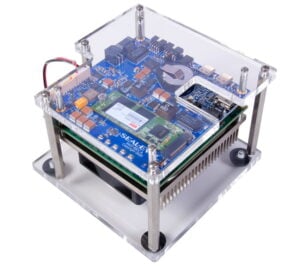 Sealevel Systems has released a new COM Express Type 6 evaluation board, designed to provide accelerated development of embedded computing prototypes for robotics applications and to reduce costs for new product introductions (NPIs).
Sealevel Systems has released a new COM Express Type 6 evaluation board, designed to provide accelerated development of embedded computing prototypes for robotics applications and to reduce costs for new product introductions (NPIs).
Originally developed to control robotic exoskeleton systems, the compact board design expanded in functionality to facilitate a wide range of other applications. At 95 millimeters square, the 12009 is identical in size to a Compact Type 6 COM Express module. Designed to meet a wide variety of application needs, the 12009 evaluation board supplies a diverse I/O mix and robust processing support. Standard I/O includes Gigabit Ethernet, USB 3.0, USB 2.0, GPIO, RS-232, and Mini DisplayPort. The carrier board is designed for the congatec conga-TC370 COM Express family, with support for 8th generation Intel Core processors, up to 64 GB DDR4 RAM, and TPM 2.0 support. The 12009 features a wide operating temperature range of 0ºC to 70ºC and is powered via a locking, four-position Molex Micro-Fit connector.
The complete evaluation kit includes a Type 6 module with Intel Core i3-8145UE CPU and 8 GB DDR4 RAM. Additionally, to improve the development process, the kit includes a 128GB M.2 SATA SSD module (supports Windows and Linux operating systems), desktop power supply, and a wide variety of cables to facilitate connections to serial and Ethernet ports and optional fans. A power button and power-indicating LED are also included.
I/O for the COM Express Compact Type 6 Evaluation Board includes:
Two 10/100/1000 Gigabit Ethernet Headers
Two USB 3.0 Type-C Connectors
Three USB 2.0 Headers
Four GPIO Headers
One RS-232 Header
One UART Interface
One Mini DisplayPort Connector
One M.2 SATA SSD Interface
Jeff Baldwin, Director of Engineering for Sealevel, commented: “We’ve pushed ourselves – and our products – to achieve extreme operating temperatures and to meet and exceed rigorous shock and vibration requirements for rugged applications. Adding on size constraints to optimize SWaP and achieve maximum functional density makes for a rewarding challenge – once we achieve it.”










